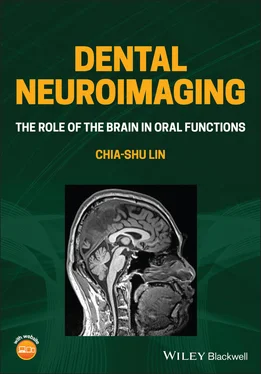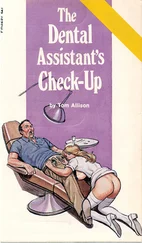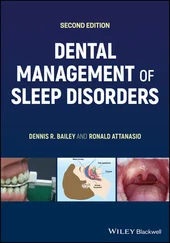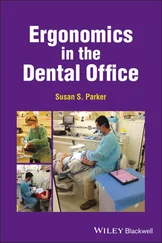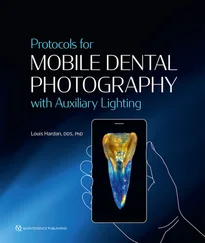Chia-shu Lin - Dental Neuroimaging
Здесь есть возможность читать онлайн «Chia-shu Lin - Dental Neuroimaging» — ознакомительный отрывок электронной книги совершенно бесплатно, а после прочтения отрывка купить полную версию. В некоторых случаях можно слушать аудио, скачать через торрент в формате fb2 и присутствует краткое содержание. Жанр: unrecognised, на английском языке. Описание произведения, (предисловие) а так же отзывы посетителей доступны на портале библиотеки ЛибКат.
- Название:Dental Neuroimaging
- Автор:
- Жанр:
- Год:неизвестен
- ISBN:нет данных
- Рейтинг книги:4 / 5. Голосов: 1
-
Избранное:Добавить в избранное
- Отзывы:
-
Ваша оценка:
- 80
- 1
- 2
- 3
- 4
- 5
Dental Neuroimaging: краткое содержание, описание и аннотация
Предлагаем к чтению аннотацию, описание, краткое содержание или предисловие (зависит от того, что написал сам автор книги «Dental Neuroimaging»). Если вы не нашли необходимую информацию о книге — напишите в комментариях, мы постараемся отыскать её.
Provides the latest neuroimaging-based evidence on the brain mechanisms of oral functions Dental Neuroimaging: The Role of the Brain in Oral Functions
Dental Neuroimaging: The Role of the Brain in Oral Functions
Dental Neuroimaging — читать онлайн ознакомительный отрывок
Ниже представлен текст книги, разбитый по страницам. Система сохранения места последней прочитанной страницы, позволяет с удобством читать онлайн бесплатно книгу «Dental Neuroimaging», без необходимости каждый раз заново искать на чём Вы остановились. Поставьте закладку, и сможете в любой момент перейти на страницу, на которой закончили чтение.
Интервал:
Закладка:
| 1.1 | Trends of the academic publication in dental research related to brain and neuroimaging. |
| 1.2 | Selected findings (since 2010) of neuroimaging research, which are related to the issues of the ‘landmark discoveries or concepts’ of oral neuroscience (Iwata and Sessle 2019), as quoted in field (A) to (G). |
| 1.3 | Selected findings (since 2010) of brain imaging research related to the clinical disciplines of dentistry. |
| 4.1 | Meta-analyses of neuroimaging findings of the motor area (since 2015). |
| 4.2 | Neuroimaging research on the brain mechanisms of mastication (since 2015). |
| 4.3 | Neuroimaging research on brain mechanisms of swallowing (since 2015). |
| 5.1 | Neuroimaging research on brain mechanisms of oral somatosensory processing (since 2015). |
| 5.2 | Neuroimaging research on brain mechanisms of taste or food stimuli (since 2015). |
| 5.3 | Neuroimaging research on brain mechanisms of oral multisensory processing. |
| 6.1 | Recent meta-analytical findings on neuroimaging research on pain (since 2015). |
| 6.2 | Neuroimaging research on brain mechanisms of central sensitization and pain (since 2015). |
| 6.3 | Neuroimaging research on brain mechanisms of pain related to temporomandibular disorders (since 2015). |
| 6.4 | Neuroimaging research on brain mechanisms of pain related to trigeminal neuralgia and painful neuropathy (since 2015). |
| 6.5 | Neuroimaging research on brain mechanisms of burning mouth syndrome (since 2015). |
| 6.6 | Definition of fear, anxiety and phobia. |
| 6.7 | Neuroimaging research on brain mechanisms of dental fear/anxiety. |
| 7.1 | Recent findings on age-related changes in oral sensorimotor functions (since 2015). |
| 7.2 | Neuroimaging research on brain mechanisms of aging and oral functions (since 2015). |
| 7.3 | Neuroimaging research on brain mechanisms of oral functions and neurodegenerative disorders (since 2010), see also Table 7.2. |
| 8.1 | Neuroimaging research on brain mechanisms of brain plasticity and oral functions (since 2010). |
| 8.2 | Neuroimaging research on brain mechanisms of training/intervention to improve swallowing (since 2015). |
| 9.1 | Proposed components of the brain–stomatognathic integrative assessment (BSIA). |
| 9.2 | Recent findings on neuroimaging research on oral functions based on animal models (since 2015). |
List of Boxes
| 2.1 | From the Brain to Behaviour – It Is All about the Energy! |
| 2.2 | From Tools to Discovery – Basic Skills about Reading Neuroimaging Data |
| 2.3 | From Tools to Discovery – Key Concepts in the Processing of Imaging Data |
| 2.4 | From Tools to Discovery – Brain Mapping and the Use of the Brain Atlas |
| 2.5 | From Research to Practice – There Is Something More Important Than an ‘Image’ for Neuroimaging |
| 3.1 | From the Brain to Behaviour – Brain Mechanisms of Rating One’s Feeling |
| 4.1 | From Tools to Discovery – Meta-analysis of Neuroimaging Findings |
| 4.2 | From Research to Practice – Better Brain, Better Chewing? |
| 4.3 | From Tools to Discovery – How to Draw a Conclusion From a Neuroimaging Study |
| 5.1 | From Research to Practice – Why Is Orofacial Apparatus So Sensitive? |
| 6.1 | From Research to Practice – Revision of the Definition of Chronic Pain by Neuroimaging Evidence |
| 7.1 | From the Brain to Behaviour – Sensorimotor Adaptation |
| 7.2 | From the Brain to Behaviour – Executive Function of the Brain |
List of Abbreviations
ACCanterior cingulate cortexADaxial diffusivityALEactivation likelihood estimationASLarterial spin labellingAzDAlzheimer’s diseaseBGbasal gangliaBMSburning mouth syndromeBOLDblood‐oxygen‐level‐dependentCDcomplete dentureCMAcortical masticatory areaCNScentral nervous systemCPGscentral pattern generatorsCSFcerebrospinal fluidCTcomputed tomographyDMNdefault mode networkdMRIdiffusion magnetic resonance imagingDTIdiffusion tensor imagingEEGelectroencephalographyEMGelectromyographyERPevent‐related potentialFAfractional anisotropyfMRIfunctional magnetic resonance imagingfNIRSfunctional near‐infrared spectroscopyIODimplant‐supported dentureM1primary motor cortexMBFmaximal biting forceMCImild cognitive impairmentMDmean diffusivityMEGmagnetoencephalographyMPmasticatory performancemPFCmedial prefrontal cortexMRImagnetic resonance imagingMRSmagnetic resonance spectroscopyMTPmaximal tongue pressureMVPAmultivariate pattern analysisNAcnucleus accumbensNRSnumerical rating scaleOFCorbitofrontal cortexPAGperiaqueductal greyPDParkinson's diseasePETpositron emission tomographyPFCprefrontal cortexPMCpremotor cortexQSTquantitative sensory testingRDradial diffusivityrs‐fMRIresting‐state functional magnetic resonance imagingrTMSrepetitive transcranial magnetic stimulationS1primary somatosensory cortexS2secondary somatosensory cortexSFRsalivary flow rateSMAsupplementary motor areasMRIstructural magnetic resonance imagingSPECTsingle photon emission computed tomographyTDCStranscranial direct current stimulationTMDtemporomandibular disordersTMStranscranial magnetic stimulationTNtrigeminal neuralgiaTNPtrigeminal neuropathic painVASvisual analogue scaleVBMvoxel‐based morphometryVDSverbal descriptor scale
Preface
About 20 years ago when I just finished my DDS programme, new frontiers were rapidly expanding in dentistry and brain science. Dentistry was markedly revolutionized by innovations in biological, material and digital technology. Brain science, with the use of non‐invasive neuroimaging approaches, has risen as a mainstream field in clinical science. At the beginning of the twenty‐first century, we have witnessed the advancement of neuroimaging in various health‐related fields, such as neurodegenerative disorders and psychiatric diseases. In contrast, our knowledge of the stomatognathic system is largely based on animal and clinical research, and the brain's role in oral functions has not been fully elucidated. During my college days, the topic of the human brain and mental functions has been rarely discussed in dental textbooks.
This book responds to the evolution of using neuroimaging approaches to investigate the human brain and oral functions, which has been lasting for decades and become gradually popular in recent years. As a relatively uncharted field, ‘dental neuroimaging’ is not merely an adoption of a new method in dental research. It also focuses on the cross‐disciplinary investigation about the connection between the brain, the stomatognathic system and oral health‐related behaviour. As shown in the book, neuroimaging studies have provided many insights on the mechanisms of oral diseases, such as chronic orofacial pain and swallowing and masticatory dysfunctions. Moreover, as I have emphasized in this book, the knowledge from neuroimaging research also contributes to translational application in clinical management, such as the management of geriatric and special needs patients.
Undeniably, a single book will not cover all the progress of neuroimaging research related to oral health. The book focuses on the future directions and challenges of dental neuroimaging research rather than merely a conclusion of past knowledge about the brain and oral functions. In this book, while the key results from classic research works are summarized, more emphasis is put on recent findings and the current trend in neuroimaging research of oral topics.
Читать дальшеИнтервал:
Закладка:
Похожие книги на «Dental Neuroimaging»
Представляем Вашему вниманию похожие книги на «Dental Neuroimaging» списком для выбора. Мы отобрали схожую по названию и смыслу литературу в надежде предоставить читателям больше вариантов отыскать новые, интересные, ещё непрочитанные произведения.
Обсуждение, отзывы о книге «Dental Neuroimaging» и просто собственные мнения читателей. Оставьте ваши комментарии, напишите, что Вы думаете о произведении, его смысле или главных героях. Укажите что конкретно понравилось, а что нет, и почему Вы так считаете.
